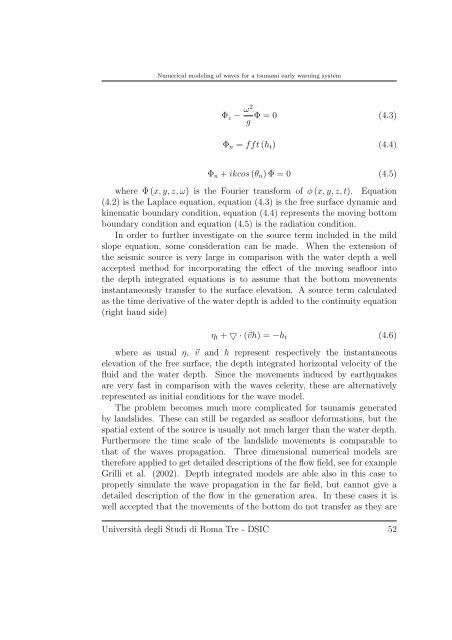Numerical modeling of waves for a tsunami early warning system
Numerical modeling of waves for a tsunami early warning system
Numerical modeling of waves for a tsunami early warning system
You also want an ePaper? Increase the reach of your titles
YUMPU automatically turns print PDFs into web optimized ePapers that Google loves.
<strong>Numerical</strong> <strong>modeling</strong> <strong>of</strong> <strong>waves</strong> <strong>for</strong> a <strong>tsunami</strong> <strong>early</strong> <strong>warning</strong> <strong>system</strong><br />
Φz − ω2<br />
Φ = 0 (4.3)<br />
g<br />
Φn = fft(ht) (4.4)<br />
Φn + ikcos (θn)Φ=0 (4.5)<br />
where Φ (x, y, z, ω) is the Fourier trans<strong>for</strong>m <strong>of</strong> φ (x, y, z, t). Equation<br />
(4.2) is the Laplace equation, equation (4.3) is the free surface dynamic and<br />
kinematic boundary condition, equation (4.4) represents the moving bottom<br />
boundary condition and equation (4.5) is the radiation condition.<br />
In order to further investigate on the source term included in the mild<br />
slope equation, some consideration can be made. When the extension <strong>of</strong><br />
the seismic source is very large in comparison with the water depth a well<br />
accepted method <strong>for</strong> incorporating the effect <strong>of</strong> the moving seafloor into<br />
the depth integrated equations is to assume that the bottom movements<br />
instantaneously transfer to the surface elevation. A source term calculated<br />
as the time derivative <strong>of</strong> the water depth is added to the continuity equation<br />
(right hand side)<br />
ηt + ▽·(vh) =−ht<br />
(4.6)<br />
where as usual η, v and h represent respectively the instantaneous<br />
elevation <strong>of</strong> the free surface, the depth integrated horizontal velocity <strong>of</strong> the<br />
fluid and the water depth. Since the movements induced by earthquakes<br />
are very fast in comparison with the <strong>waves</strong> celerity, these are alternatively<br />
represented as initial conditions <strong>for</strong> the wave model.<br />
The problem becomes much more complicated <strong>for</strong> <strong>tsunami</strong>s generated<br />
by landslides. These can still be regarded as seafloor de<strong>for</strong>mations, but the<br />
spatial extent <strong>of</strong> the source is usually not much larger than the water depth.<br />
Furthermore the time scale <strong>of</strong> the landslide movements is comparable to<br />
that <strong>of</strong> the <strong>waves</strong> propagation. Three dimensional numerical models are<br />
there<strong>for</strong>e applied to get detailed descriptions <strong>of</strong> the flow field, see <strong>for</strong> example<br />
Grilli et al. (2002). Depth integrated models are able also in this case to<br />
properly simulate the wave propagation in the far field, but cannot give a<br />
detailed description <strong>of</strong> the flow in the generation area. In these cases it is<br />
well accepted that the movements <strong>of</strong> the bottom do not transfer as they are<br />
Università degli Studi di Roma Tre - DSIC 52

















